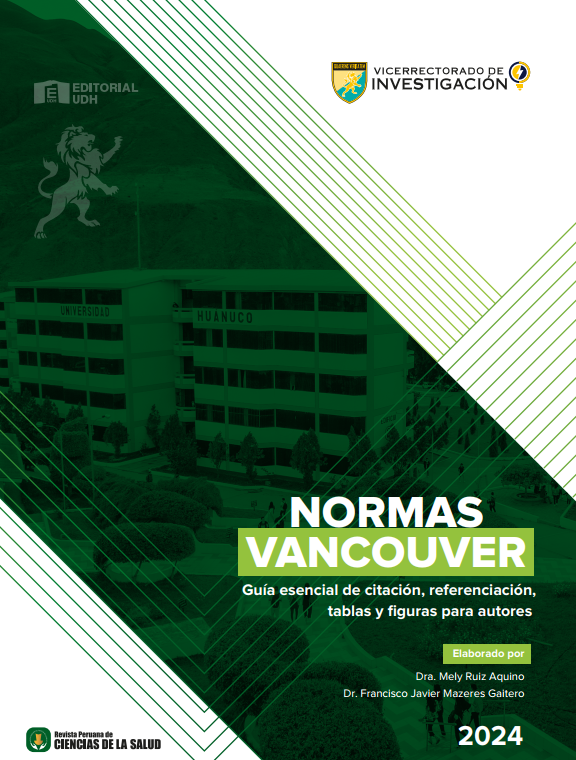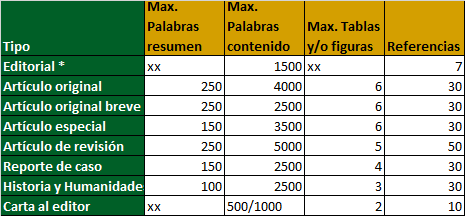Seroprevalencia de anticuerpos contra la Brucella sp. en ganaderos del distrito San José de Lourdes, Cajamarca
DOI:
https://doi.org/10.37711/rpcs.2021.3.2.303Palabras clave:
Brucelosis, estudios seroepidemiológicos, pruebas serológicas, comunidad ruralResumen
Objetivo. Determinar la seroprevalencia de anticuerpos contra la Brucella sp. e identificar los factores predisponentes y la sintomatología asociada en los ganaderos del distrito San José de Lourdes (San Ignacio) en el departamento de Cajamarca, durante los meses de setiembre a diciembre del 2019. Métodos. El estudio fue de tipo observacional, transversal, prospectivo con un diseño exploratorio-descriptivo. Se realizó un muestreo probabilístico, donde se analizaron 147 sueros sanguíneos pertenecientes a ganaderos de ambos géneros. La seroprevalencia de anticuerpos se determinó mediante las pruebas Rosa de Bengala y antígeno de Huddleson y se aplicó una encuesta estructurada para identificar los factores predisponentes y la sintomatología asociada a la enfermedad. Resultados. Se encontró que, 17 % de ganaderos seropositivos a Brucella sp. mantuvo contacto directo prolongado con el ganado bovino (p < 0,05). Además, el 23,8 % de ganaderos presentó anticuerpos contra la Brucella sp, siendo principalmente mujeres (15,6 %). Los ganaderos con anticuerpos contra la Brucella sp. consumían queso (22,4 %), leche (19,7 %) y sangre de animales sacrificados (17 %) (p > 0,05). Los síntomas más recurrentes fueron el dolor de cabeza (19 %), fatiga (14,3 %), dolor articular (13,6 %), fiebre e insomnio (10,2 %). Conclusiones. La seroprevalencia de anticuerpos contra la Brucella sp. es alta y está asociada al contacto directo prolongado con el ganado bovino y a síntomas como el dolor de cabeza y la fiebre, presentes en la población evaluada. Los resultados obtenidos permiten evidenciar la preocupante situación que viven los ganaderos de San José de Lourdes, además de la escasa cultura preventiva existente.
Descargas
Referencias
1. Brucelosis [Internet] Ginebra: Organización Mundial dela Salud; 2020 [Consultado 2020 Dic 20] Disponible en: https://www.who.int/es/news-room/factsheets/detail/brucellosis
2. Escobedo L, Falcón N. Características epidemiológicasy clínicas de infecciones por Brucella melitensis en pacientes del Hospital Nacional «Daniel A. Carrión», Callao, Perú (2007-2014). Rev. investig. vet. Perú [Internet]. 2018 Jul; 29 (3): 1018-24 [Consultado 2020 Dic 20]. Disponible en: http://www.scielo.org.pe/scielo.php?script=sci_arttext&pid=S1609-91172018000300034&lng=es http://dx.doi.org/10.15381/rivep.v29i3.14834
3.Hull NC, Schumaker BA. Comparisons of brucellosis between human and veterinary medicine. Infect. Ecol. Epidemiol. [Internet].2018 Jul; 8(1): 1-29 [Consultado 2020Dic 20]. Disponible en: https://doi.org/10.1080/20008686.2018.1500846
4. Sánchez JM, Gabriel AE. Anuario estadístico 2018. Lima:Ministerio de Salud, Instituto Nacional de Salud; 2018.
5. Dirección General de Políticas Agrarias. Diagnóstico deCrianzas Priorizadas para el Plan Ganadero 2017-2021.Lima: Ministerio de Agricultura y Riego; 2017.
6. Valle T, Lago Y, García I. Resultados de intervención educativa sobre brucelosis humana en zonas de riesgo de en-fermar en Argelia. Rev. Ciencias Médicas de Pinar del Río[Internet]. 2018 Ago; 22(4): 153-63 [consultado 2020 Jun20]. Disponible en: http://scielo.sld.cu/scielo.php?script=sci_arttext&pid=S1561-31942018000400017&lng=es
7. Dirección de Epidemiología. Enfermedades infecciosasbrucelosis. Guía para el equipo de salud. Argentina: Ministerio de Salud de la Nación; 2013.
8. Rosales C, Puentes C, Arias O, Romero JJ. Aspectos epidemiológicos de la brucelosis en humanos en las ÁreasRectoras Aguas Zarcas y Los Chiles, Costa Rica, 2015-2017. Rev. Ciencias Veterinarias [Internet] 2020 Feb; 38(1): 1-6 [Consultado 2020 Dic 20]. Disponible en: https://doi.org/10.15359/rcv.38-1.1
9. Olivares R, Vidal P, Sotomayor C, Norambuena M, LuppiM, Silva F, et al. Brucelosis en Chile: descripción de unaserie de 13 casos. Rev Chil Infectol. [Internet] 2017 Jun;34: 243-47 [Consultado 2020 Dic 20]. Disponible en:http://dx.doi.org/10.4067/S0716-10182017000300006
10. Morales-García R, García-Méndez N, Regalado-Jacobo D, López-Merino A, Contreras-Rodríguez A. Seguimiento clínico, serológico y mediante la reacción depolimerasa en cadena de una familia con brucelosis.Rev. chil. Infectol. [Internet] 2014 Ago; 31(4): 425-33 [Consultado 2020 Jun 20]. Disponible en: https://scielo.conicyt.cl/scielo.php?script=sci_arttext&pid=S0716-10182014000400008&lng=es
11. Pisani A, Vacarezza M, Tomasina F. Estudio de 14 casosde brucelosis en trabajadores de un frigorífico comoenfermedad profesional. Uruguay 2009-2010. Rev MédUrug [Internet]. 2017 Sep; 33(3): 93-8 [Consultado 2020Jun 20]. Disponible en: http://dx.doi.org/10.29193/rmu.33.3.1
12. Santa Cruz-López CY. Seroprevalencia de brucelosis enel personal que labora en camales del departamento de Lambayeque. Junio 2014 – febrero 2015 [Tesis de maes-tría en Ciencias] La libertad: Universidad Nacional deTrujillo; 2015.
13. Zurita S. Procedimientos de laboratorio: manual: labo-ratorios locales I Laboratorios locales II. Lima: Ministeriode Salud, Instituto Nacional de Salud; 2013.
14. Spinreact. Rose Bengal. Slide agglutination [Internet] España: [Consultado 2019 Sep 20] Disponible en: https://www.spinreact.com/files/Inserts/Serologia/SGIS07_-_Ref._1200901_Rosa_Bengala_04-2013.pdf
15. Wiener-lab. Antígenos Febriles [Internet] [Consultado2019 Sep 20] Disponible en: https://www.wiener-lab.com.ar/VademecumDocumentos/Vademecum%20es-panol/antigenos_febriles_sp.pdf
16. Obregón A, Muñoz K, Echevarría E, Rodríguez Y, Rodríguez J, Valdés Y, et al. Evaluación del sistema serológicoFebrille Antigen Brucella para la pesquisa de anticuerpos contra brucelas, en Cuba. Rev Cubana Med Trop. [Internet]. 2015 Dic; 67(3): 1-9 [Consultado 2019 Sep 20]. Disponible en: http://scielo.sld.cu/scielo.php?script=sci_arttext&pid=S037507602015000300001&lng=es
17. Cevallos O, Carranza M, Saucedo S, Romero D, RamosL, Reyes X. Diagnóstico serológico (Rosa de Bengala) ymolecular (PCR) de brucelosis en humano. Rev. Ciencia y tecnología. [Internet]. 2010 Ene;1(3):27-32 [Consultado2019 Sep]. Disponible en: https://uteq.edu.ec/revista-cyt/publico/archivos/C1_5n12010.pdf
18. Toledo E, Delgado C, Suarez A, Noé M. Prevalencia deBrucelosis Caprina en tres distritos de la provincia de Cañete, Lima. Rev. Inv. Vet. Perú. [Internet] 2007 Jul;18(2):136-40 [Consultado 2019 Sep 20]. Disponible en: http://www.scielo.org.pe/scielo.php?script=sci_arttext&pi-d=S160991172007000200008&lng=es
19. Zambrano MD, Pérez M, Rodríguez X. Brucelosis Bovinaen la Provincia Manabí, Ecuador: Estudio de los Factores de Riesgo. Rev. investig. vet. Perú. [Internet] 2016 Sep;27(3): 607-17 [Consultado 2020 Sep 20]. Disponible en:http://dx.doi.org/10.15381/rivep.v27i3.11995
20. Cervera-Hernández ME, Ordaz-Vázquez A, Torres-González P, Chávez-Mazari B, Soberanis-Ramos O, Sifuentes-Osornio J, et al. Seroprevalence of brucellosis among dairy farm workers in Mexico. Sal públ Méx. [Internet]2016 May; 58 (3): 366-70 [Consultado 2020 Sep 20]. Disponible en: https://saludpublica.mx/index.php/spm/article/view/7896
21. Méndez-Lozano M, Rodríguez E, Sánchez L. Brucelosis,una zoonosis presente en la población: estudio de series de tiempo en México. Rev Sal Pub México [Internet]. 2015 Dic; 57(6): 519-27 [Consultado 2020 Sep 20]. Dis-ponible en: http://www.scielo.org.mx/scielo.php?script=sci_arttext&pid=S003636342015000600010&lng=es
22.Navarro A, Bustamante J, Guillen A. Estrategias de prevención y control de la brucelosis humana en el Perú. Rev Perú Med Exp Salud Publica. [Internet]. 2005 Abr;22: 87 [Consultado 2020 Nov 20]. Disponible en: http://www.scielo.org.pe/scielo.php?script=sci_arttext&pi-d=S172646342005000200001&lng=es
23. Oliveira C, Almeida J, Feitosa A, Firmino S, Rocha M, DaSilva-Júnior F. Prevalencia de la Brucella spp en humanos. Rev. Lat. Am. Enferm. [Internet] 2015 Oct; 23(5): 919-26[Consultado 2020 Nov 20]. Disponible en: https://doi.org/10.1590/0104-1169.0350.2632
24. Doganay M, Aygen B. Human brucellosis: an overview. International Journal of Infectious Diseases [Internet] 2003;7(3): 173-82 [Consultado 2020 Nov 20] Disponible en: ht-tps://www.ijidonline.com/article/S1201-9712(03)90049-X/pdf https://doi.org/10.1016/S1201-9712(03)90049-X

Descargas
Publicado
Número
Sección
Licencia
Derechos de autor 2021 Escolana Julcahuanca, Edit Pérez, Cinthya Santa Cruz-López, Marcela Saldaña

Esta obra está bajo una licencia internacional Creative Commons Atribución 4.0.





















